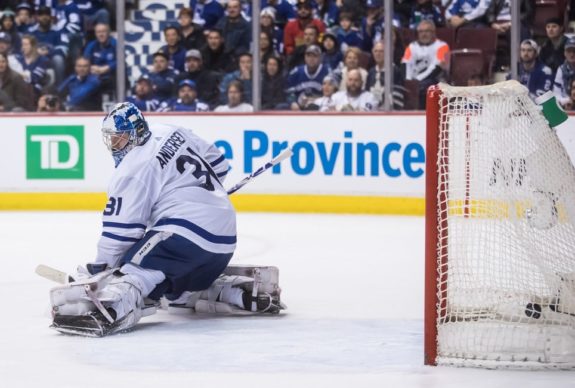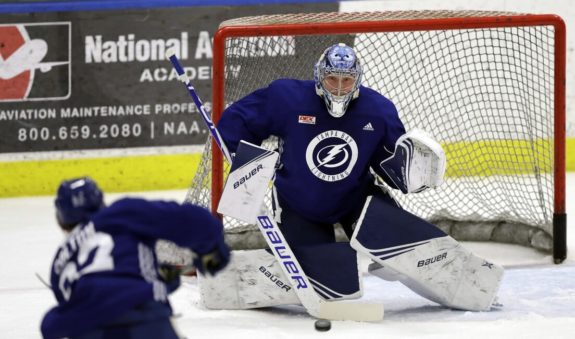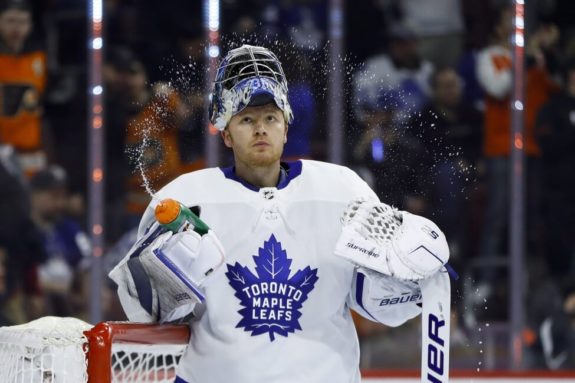When it comes to goalies in fantasy hockey, many people choose to take the best available player. However, taking a goalie early in your draft is likely not a smart move since — in most leagues — the bulk of your scoring comes from your skaters. However, there are always good options for goalies early, and if you can take either Andrei Vasilevskiy or Frederik Andersen, your team’s goaltending should be solid.
Related: Fantasy Focus: Top Goalies 2019-20
Vasilevskiy has been a Vezina Trophy finalist in each of the last two seasons, and he won it last season. Although he missed time with a broken foot, he had 39 wins and career highs in save percentage (SV%), goals against average (GAA), quality start percentage (QS%) and goals saved above average (GSAA).
Andersen was also a strong netminder for the Toronto Maple Leafs with 36 wins. Both Andersen and Vasilevskiy are great options in your fantasy league, but who should you go with? Let’s break it down.
Scoring
Wins
Both goalies are on two of the top teams in the Eastern Conference and the NHL, so they’re going to win games. However, they are in the same division and will likely be competing for the Atlantic Division title, making every win more meaningful. Last year, Andersen won 36 of his 60 games played, and he’s had at least 30 wins in each of the last three seasons. On the other hand, Vasilevskiy won 39 games in 53 starts last season and won 44 games in 2017-18.

Heading into the 2019-20 season, the Lightning likely won’t be as good, and many expect the Maple Leafs to take a step forward this season. Both goalies should get at least 35 wins if they’re healthy, but there’s no clear-cut winner here.
Winner: Even
Save Percentage
Since he has been the Lightning’s No. 1 goaltender, Vasilevskiy’s SV% has increased each season. Last year, it was a career-high .925, which was sixth in the NHL. Throughout Andersen’s career, he has been fairly steady in this statistic — usually right around the .917 to .920 mark. His save percentage last year was .917 — his lowest mark since 2014-15 — but he has arguably played better than the statistic suggests. However, the edge still goes to Vasilevskiy in this category, simply because he has been at or above the .920 SV% threshold every season.
Winner: Vasilevskiy
Goals Against Average
In his three seasons with the Anaheim Ducks, Andersen never had a GAA higher than 2.38. In Toronto, however, he has averaged a 2.75 GAA over three seasons. He had a 2.77 GAA last season, which isn’t bad at all, but it’s a significant increase from the 2.30 range. Vasilevskiy was ninth in the league with a 2.40 GAA last year and his career mark is 2.55. Andersen’s is 2.59, but over the last three seasons, Vasilevskiy has simply been better than Andersen in this category. Expect the same this season, but Andersen will still have a serviceable GAA.
Winner: Vasilevskiy

Shutouts
In 2017-18, Vasilevskiy had a league-high eight shutouts and had six last year, which tied for fourth-best in the league. Surprisingly, Andersen had just one shutout in his 60 games. That’s a low number that should be better this season, but Vasilevskiy still has the edge given his recent success.
Related: Lightning Extend Goaltender Vasilevskiy
Winner: Vasilevskiy
Advanced Statistics
There are a few statistics that most fantasy leagues don’t look at that paint a better picture as to just how well goalies are playing, specifically QS%, GSAA, and goalie point shares (GPS).
Quality Start Percentage
The league average QS% is about .530, and both Vasilevskiy and Andersen were at least 100 points higher than that. Vasilevskiy was at .642, and among goalies with at least 30 starts, that put him third in the league. Andersen was at .633 and seventh in the league among qualified goalies. The main takeaway from this number is that both goalies will, more times than not, give their team a chance to win each night.
Winner: Even

Goals Saved Above Average
According to Hockey Reference, GSAA is the goals the goalie prevented given his save percentage and shots faced relative to the league average save percentage on the same number of shots. Andersen had a plus-14.48 GSAA last season, meaning he was preventing about 14.5 more goals than the league-average goalie. Vasilevskiy had a plus-26.40 GSAA, and that was second in the league only behind Ben Bishop. Both Vasilevskiy and Andersen have increased their GSAA over the past few seasons, but Vasilevskiy nearly doubled Andersen in this category.
Winner: Vasilevskiy
Goalie Point Shares
Goalie point shares are the number of points a goalie contributes to his play in goal, and both Andersen and Vasilevskiy are strong in this category. Andersen was second in the league with a 12.5 GPS and Vasilevskiy was third at 12.4. If Vasilevskiy had played a full season, his GPS likely would have been higher, but both goalies are strong options if this stat is taken into account for your fantasy league.
Winner: Even
Who To Pick
If Vasilevskiy is available in your league, take him. He’s the reigning Vezina Trophy winner and there’s no question he is one of the elite goaltenders in the league. If he’s already been taken, however, Andersen is still a good option. He will win games and post decent numbers, but they won’t be to the level that Vasilevskiy will likely reach this season.